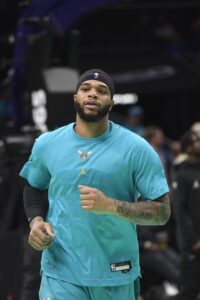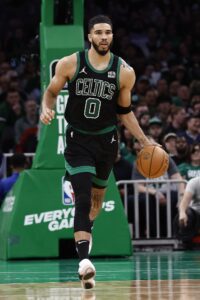Hoops Rumors is checking in on the 2024 offseason for all 30 NBA teams, recapping the summer’s free agent signings, trades, draft picks, departures, and more. We’ll take a look at each team’s offseason moves and consider what might still be coming before the regular season begins. Today, we’re focusing on the Charlotte Hornets.
Free agent signings
 Miles Bridges: Three years, $75,000,000. Re-signed using Bird rights.
Miles Bridges: Three years, $75,000,000. Re-signed using Bird rights.- Seth Curry: One year, minimum salary. Signed using minimum salary exception.
- Taj Gibson: One year, minimum salary. Partially guaranteed ($1,082,270). Signed using minimum salary exception.
Trades
- Acquired Devonte’ Graham and the Pelicans’ 2025 second-round pick from the Spurs in exchange for cash.
- Note: Graham was subsequently waived.
- Acquired Josh Green, Reggie Jackson, the Nuggets’ 2029 second-round pick, and the Nuggets’ 2030 second-round pick from the Mavericks and Nuggets in a six-team trade in exchange for the Sixers’ 2025 second-round pick (to Mavericks or Timberwolves) and cash (to Nuggets).
- Note: Jackson was subsequently bought out.
Draft picks
- 1-6: Tidjane Salaun
- Signed to rookie scale contract (four years, $34,035,472).
- 2-42: KJ Simpson
- Signed to two-year, two-way contract.
Two-way signings
Departed/unsigned free agents
Other moves
Salary cap situation
- Went below the cap to use room.
- Now operating over the cap ($140.6MM) and below the luxury tax line ($170.8MM).
- Carrying approximately $153.6MM in salary.
- Hard-capped at $188,931,000.
- Full room exception ($8MM) available.
The offseason so far
The Hornets only won 21 games in 2023/24, their lowest mark in over a decade, but there were a few positive developments over the course of the season – the first under their new ownership group – that may pay off for the franchise in the long run.
For one, last year’s No. 2 overall pick Brandon Miller looks like a long-term building block and a future star. Charlotte also made a smart mid-season pivot, accepting the best offers on the trade market for veterans Terry Rozier, P.J. Washington, and Gordon Hayward, which netted the club several future draft assets. Finally, the team made a front office change in the spring, hiring Jeff Peterson to be its new head of basketball operations.
It will take some time before we can really evaluate several of the moves Peterson made during his first offseason at the helm. For instance, his head coaching hire looks like a good one — Charles Lee has received rave reviews for his work as an assistant. But first-time head coaches don’t come without risk, so it remains to be seen whether Lee’s transition to a lead role is a smooth one.
The biggest roster move the Hornets made this summer was re-signing forward Miles Bridges to a three-year, $75MM contract as an unrestricted free agent. That looks like a fair deal based on his on-court production, but Bridges’ history of domestic violence cases can’t be ignored. The hope in Charlotte is that Bridges’ past behavior is fully in the rear-view mirror and that he’ll be an upstanding citizen going forward, but you can certainly make a case that the Hornets never should have made that sort of investment to a player with those allegations on his record.
 The Hornets’ 2024 lottery pick doesn’t come without risk either, albeit for entirely different reasons — Tidjane Salaun just turned 19 last week and isn’t considered likely to make an NBA impact as a rookie. Many people around the league were surprised Salaun was selected as high as No. 6, according to ESPN’s Jeremy Woo; ESPN’s Jonathan Givony describes him as a player who is “still just getting his feet wet at the highest levels.” That doesn’t mean Salaun won’t become an impact player down the road, but Charlotte will have to be patient with his development.
The Hornets’ 2024 lottery pick doesn’t come without risk either, albeit for entirely different reasons — Tidjane Salaun just turned 19 last week and isn’t considered likely to make an NBA impact as a rookie. Many people around the league were surprised Salaun was selected as high as No. 6, according to ESPN’s Jeremy Woo; ESPN’s Jonathan Givony describes him as a player who is “still just getting his feet wet at the highest levels.” That doesn’t mean Salaun won’t become an impact player down the road, but Charlotte will have to be patient with his development.
The Hornets operated under the cap this offseason, with Peterson using that room to accommodate a handful of salary dumps (Devonte’ Graham, Reggie Jackson, Josh Green) rather than pursuing outside free agents.
Graham and Jackson came with draft picks attached and were subsequently waived, whereas Green – a 23-year-old wing with a three-and-D skill set – projects to be a rotation player in Charlotte going forward. He’s under contract through the 2026/27 season.
Up next
The Hornets still have roster spots to fill before the regular season begins, with 14 players on standard contracts and a pair on two-way deals.
While the team could leave that 15th standard roster spot open to start the season, there’s no real reason not to fill it, given how far Charlotte’s team salary is from the luxury tax line. If the Hornets aren’t yet prepared to commit to a player for the full season, they could carry a 15th man with a non-guaranteed salary this fall.
Tre Mann, who was acquired from the Thunder at the 2024 trade deadline, is eligible for a rookie scale extension, while Cody Martin is eligible for a veteran extension. Martin isn’t a candidate for a new deal at this point, given his injury woes over the past two seasons, but Mann might be one worth watching — he made 28 starts for Charlotte down the stretch and played well (11.9 PPG, 5.2 APG, .453/.364/.759 shooting).
That’s a relatively small sample size, so the Hornets may prefer to wait another year on Mann and then negotiate a deal with him in restricted free agency next summer. But if they’re encouraged by how he looks in camp and if the price is right, I wouldn’t be totally shocked if the two sides worked something out sooner rather than later.
The Hornets are a team to watch on the trade market during the preseason and into the season, since they can afford to take on some salary and have shown in the last eight months that they’re happy to take on unwanted contracts in order to continue stockpiling draft assets.

 [RELATED:
[RELATED: 
 The Hornets’ 2024 lottery pick doesn’t come without risk either, albeit for entirely different reasons —
The Hornets’ 2024 lottery pick doesn’t come without risk either, albeit for entirely different reasons —